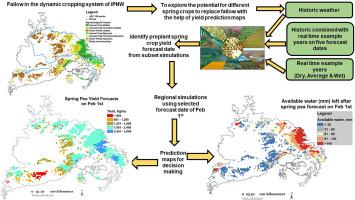Agricultural Systems ( IF 6.1 ) Pub Date : 2022-06-07 , DOI: 10.1016/j.agsy.2022.103432 Harsimran Kaur , Davis R. Huggins , Bryan Carlson , Claudio Stockle , Roger Nelson

|
CONTEXT
Dryland cropping systems in the inland Pacific Northwest (iPNW) of USA are predicted to be more dynamic with greater use of annual fallow under projected climate change. Increased use of fallow can result in soil degradation and greater cropping system uncertainty. In view of that, a regional simulation study was planned to explore for different spring crop options that can fit in place of fallow in rotation with winter wheat.
OBJECTIVE
The main goal of the study was to provide spring crop pre-plant yields and available soil water left after harvest of spring crop as forecasts at regional scales to compare fallow versus spring crop choices known here as flex-cropping.
METHODS
Model simulations were conducted using CropSyst (Cropping System Simulation model) and were based on historic (1981–2010) and historic combined with recent year's weather identified as Dry/Average/Wet. Historic weather was joined with recent weather at different forecast dates (Dec. 1st, Jan. 1st, Feb. 1st, March 1st, and April 1st). Hence, weather until forecast dates consisted of recent and historic later on. To identify a suitable forecast date, regression analysis was conducted to compare yields of spring crops on different forecast dates with corresponding yields obtained on recent weather years. Regional simulations were run on identified forecasting date to forecast yields and available water left in the profile after harvest.
RESULTS AND CONCLUSIONS
Regression analysis showed high correlation (R2) between yields obtained on forecast dates of Feb/March/April 1st with yields on recent years. Coefficient of variation (CV) was also lower for spring crops yields simulated on forecast dates of Feb/March/April 1st compared to Dec. 1st and Jan. 1st. Feb 1st was considered important to select as forecast date due to much variability in the spring crop planting across the region. Regional forecast maps of spring crop yields, their CV and available water are presented in the study. Spring pea was identified as flex-crop to intensify cropping systems in grain fallow. Spring canola and spring wheat were expected to have negative rotational impact, therefore were better options to diversify the systems in annual crop and annual crop transition areas. Keeping in mind the limitations of simulation models, this study highly recommends for validation field trials at different locations across iPNW.
SIGNIFICANCE
Maps of predicted spring crop yields, their CVs and predicted available water after fallow will aid in decision making related to intensification and diversification of iPNW.
中文翻译:

美国西北部内陆太平洋旱地休耕与弹性种植决策
语境
美国内陆太平洋西北地区 (iPNW) 的旱地耕作系统预计将更具活力,在预计的气候变化下更多地使用年度休耕。增加休耕会导致土壤退化和更大的种植系统不确定性。有鉴于此,计划进行一项区域模拟研究,以探索适合冬小麦轮作休耕的不同春季作物选择。
客观的
该研究的主要目标是提供春季作物种植前产量和春季作物收获后剩余的可用土壤水分,作为区域范围内的预测,以比较休耕与春季作物的选择,此处称为弹性种植。
方法
模型模拟是使用 CropSyst(作物系统模拟模型)进行的,并基于历史(1981-2010 年)和历史结合最近一年被确定为干/平均/湿的天气。历史天气与不同预测日期(12 月 1 日、1 月 1 日、2 月 1 日、3 月 1 日和 4 月 1 日)的近期天气相结合。因此,预报日期之前的天气包括最近的和以后的历史。为了确定合适的预测日期,进行了回归分析,将不同预测日期的春季作物产量与最近天气年份获得的相应产量进行了比较。在确定的预测日期进行区域模拟,以预测收获后剖面中的产量和可用水量。
结果和结论
回归分析显示高相关性(R 2) 在 2 月/3 月/4 月 1 日预测日期获得的产量与近年来的产量之间。与 12 月 1 日和 1 月 1 日相比,在 2 月/3 月/4 月 1 日预测日期模拟的春季作物产量的变异系数 (CV) 也较低。2 月 1 日被认为是重要的预测日期,因为该地区春季作物的播种存在很大差异。研究中提供了春季作物产量、CV 和可用水的区域预测图。春豌豆被确定为弹性作物,以加强粮食休耕的种植系统。春油菜和春小麦预计会产生负面轮作影响,因此是一年生作物和一年生作物过渡区系统多样化的更好选择。牢记仿真模型的局限性,
意义
预测春季作物产量、它们的 CV 和预测休耕后可用水的地图将有助于与 iPNW 的集约化和多样化相关的决策。











































 京公网安备 11010802027423号
京公网安备 11010802027423号